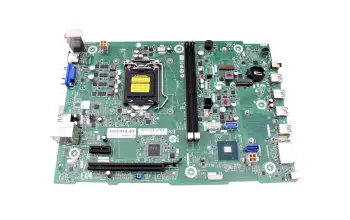Motherboards for laptops/notebooks
What is a motherboard?
As the name suggests, a motherboard is the heart of every laptop. One can also say that the motherboard is the hardware component that connects all other components. It is the most valuable and expensive part of the laptop.

Find the right motherboards by model or features
Alternative for 04Y1291 original Lenovo Mainboard (onboard GPU)

plus shipping charges
04Y1290 original Lenovo Mainboard (onboard GPU)

plus shipping charges
90MS00D0-R01000 original Asus Mainboard (onboard CPU/GPU)

plus shipping charges
60MS00D0-MB0A07 original Asus Mainboard (onboard CPU/GPU)

plus shipping charges
L75365-001 original HP Mainboard

plus shipping charges
Components of the motherboard
The main processor or CPU (Central Processing Unit) is the central processing unit and is used to process instructions. With older mainboards, the CPU sits on the so-called CPU socket and is exchangeable. For newer motherboards it is soldered directly to the motherboard for cost reasons during production. This results in the disadvantage that the newer mainboards with onboard CPU are very expensive. The rhythm in which the processor works differs depending on the model and is called the clock frequency. The main tasks of the processor are computing and controlling. The most common CPUs are those from AMD or Intel.
The RAM is the main memory that contains the temporary data needed to run the programs. The main memory can be exchanged in most cases simply over a service flap. But also here there are motherboards, which have built the memory onboard, which leads to the price of the motherboard rising.
The graphics chip or the graphics card controls the graphics output. When a program is executed, the processor calculates the data and forwards it to the graphics card. Here the data is converted so that it can be displayed on the monitor. The graphics chip is usually soldered directly to the mainboard. The graphics card can be exchanged for individual gaming notebooks.
The chipset usually consists of several integrated circuits. These guarantee problem-free communication between the various hardware components. Different voltage levels and clock frequencies are taken into account and converted to each other. The chipset can therefore also be seen as a kind of translator.
The mainboard also contains numerous interfaces and connections. These connect the individual systems with each other. There are internal interfaces, these are inside the laptop case. The external interfaces lead out of the case.
Internal mainboard interfaces: PCIe interfaces (connection for hard disks), SATA interfaces (hard disks, SSDs or optical drives), M.2 ports, RAM ports (slots), internal USB ports, fan ports
External motherboard interfaces: USB Ports, HDMI Port, VGA Port, Network Port, Power Port
Signs of a motherboard problem
Diagnosing a motherboard error is very difficult if you don't just disassemble the laptop into its parts. Common causes for such a defect are fluid damage or overheating. But a fall can also damage the motherboard or components on it. Signs of a broken mainboard can be: a completely black screen, the power LED does not light up or a defective socket.
In our series: "Notebook error patterns" we show some error pictures that can be caused by a defective motherboard and how they can be fixed without a new motherboard.
Note: Sometimes a mainboard hardware reset can solve your mainboard problem.


